|
Table of Contents |
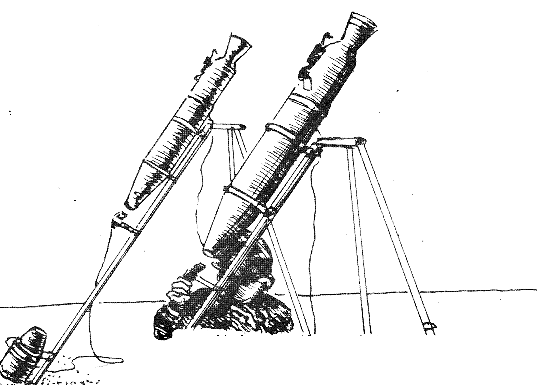
This chapter provides a standard classification and a detailed discussion of existing and reinforcing obstacles. The principles of terrain evaluation and the employment of all of obstacles to reinforce existing terrain are also presented.
PRINCIPLES OF OBSTACLE EMPLOYMENT
An obstacle is defined as any obstruction that stops, delays, or restricts movement or maneuver. Obstacles can exist naturally such as a river or a cliff, or can be man-made such as a minefield or tank ditch.
Obstacles are grouped into two general categories, existing and reinforcing, as shown. Existing obstacles are already present on the battlefield and not placed there through military effort. They may be natural such as lakes or mountains, or they can be cultural such as towns or railroad embankments. Reinforcing obstacles are placed on the battlefield through military effort and are designed to strengthen the existing terrain to slow, stop, or canalize the enemy. Reinforcing obstacles are limited only by imagination, time, manpower, or logistic constraints. They include blowing a road crater, constructing a log crib, or installing a minefield. Scatterable mines are reinforcing obstacles emplaced by various delivery systems such as artillery or aircraft.
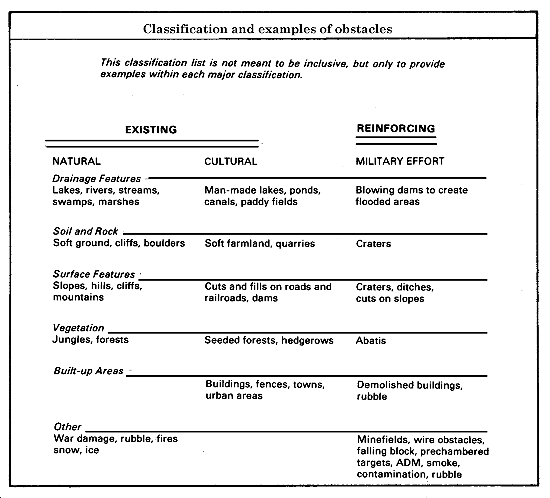
The terrain, as it exists, can be a significant asset to the commander who is best able to analyze and use it advantageously. Terrain is not just the field where the battle is fought--it is very much a part of the battle itself. The commander at any level who makes the terrain work in a positive manner against the opponent will most likely win.
There are many things a commander needs to know about the terrain on which US and enemy forces must move, maneuver, and fight. Some of the more obvious items are:
The commander's course of action will largely depend on the characteristics of the terrain and intended use of it. The commander's action includes movement, maneuver, and weapons siting to destroy the enemy. All ground movement, friendly or enemy, will be dictated by existing obstacles.
A good analysis of the terrain in the areas of influence and interest should answer the following questions:
These questions are not inclusive, but if answered and analyzed, they will provide significant information on how to prepare the battlefield and allocate combat power.
Determining existing obstacle locations is a key element in terrain analysis. The most critical questions are how and where do we get information concerning terrain and existing obstacles. The best source is an on-the-ground reconnaissance accomplished by the units who will fight the battle. However, this is not always possible due to lack of resources or enemy control of the areas about which we need information. Corps and division terrain teams organic to the Theater Army Topographic Battalion collect, analyze, and provide important topographic, hydrologic, and climatic data. Terrain analysts assess observation and fields of fire, cover and concealment, obstacles to movement, key terrain, and avenues of approach. Input to the force engineer and G-3 is especially important for obstacle planning. Engineer terrain analysts work as a team with intelligence analysts to collect raw terrain information and convert it into processed intelligence. Topographic units provide a variety of products including cross-country movement maps, overprinted maps, and various scale tactical maps. Topographic support is invaluable in making a thorough terrain analysis.
Analysis of terrain and existing obstacles should focus on the mobility of tanks. Tactics of enemy combined arms forces are designed around the mobility of tanks. The tank is the primary vehicle we want to restrict, delay, stop, and kill. This antitank orientation of terrain analysis and obstacle development narrows our focus and makes the task more simple. By focusing on the tank, the terrain analysis team can assist the commander in identifying those existing obstacles that restrict, channelize, delay, or stop the mobility of tanks.
Systematic terrain analysis using all assets available reveals the existing obstacle value of the terrain. Conditions which should be considered when analyzing terrain include drainage features, slope and relief, vegetation, cultural features, and climate. The obstacle value of each condition is evaluated individually in conjunction with trafficability. Then, their combined effects become the obstacle value of the terrain.
Drainage or surface water features include rivers, streams, canals, lakes, ponds, marshes, swamps, and bogs. Such features are obstacles whenever the water becomes deep or turbulent enough to threaten the safety of soldiers and the operation of vehicles. Drainage features are also obstacles when swamps, marshes, bogs, and the like make soil conditions impossible for cross-country movement.
Large, unfoldable rivers are formidable obstacles because they must be crossed by tactical bridging, swimming, ferrying, or special deep water fording. Ease of crossing these rivers is determined by the width, depth, velocity, turbulence, bank and bottom conditions, rapid tactical bridging available, and existing bridges.
Minor fordable rivers, streams, and canals are much more numerous than major rivers and their tactical value as obstacles should not be overlooked. These features are variable in effectiveness as obstacles. Careful planning is required to integrate them into the obstacle system. Watercourses frequently constitute elongated obstacles in terrain which may otherwise be excellent for movement. Drainage also influences the orientation of the road net and direction of movement in an area. The destruction of a few selected bridges can force cross-country movement or long detours. During floods, minor rivers and streams can become major obstacles. They can cause conditions which extend the obstacle effect for a considerable period by damaging temporary and expedient bridges, and by deepening the original channel of the river or stream, thus making access or egress difficult or impossible.
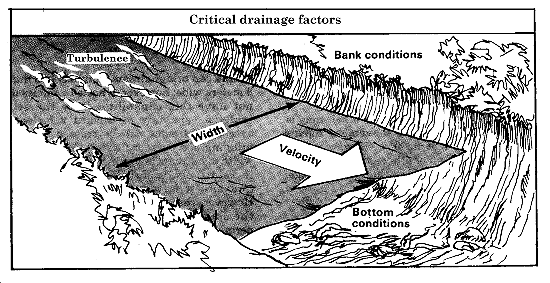
Although streams are normally small and slow during periods of low precipitation, and large and rapid during periods of high precipitation, the relationship is not always this simple. Melting snow, for example, may cause high water downstream even in regions where rainfall is low. Continuous below-freezing weather can reduce stream flow even though precipitation may be high.
In winter, ice may be strong enough to support vehicles; then, instead of being obstacles, water bodies may become the preferred avenues for movement. Lightly loaded 2 ½-ton trucks can move on ice 0.3-meter (10 inches) thick. Movement on ice is risky, however, because of weaknesses caused by water flowing from springs and other areas of swiftly moving water.
In arid regions, dry stream channels maybe preferred avenues for movement during periods of little or no flow. However, there may be quicksand or other soft places where vehicles bog down. Also, there is the danger of flash floods.
Fordability of a stream expresses how easily it may be crossed without the means of bridging or ferrying. Fordability depends on characteristics of both the vehicle and the stream. The significant characteristics of streams are:
|
IF DEPTH AND BOTTOM PERMIT ACCESS AND EGRESS. |
These characteristics may vary independently so that fording of even the smallest stream requires selecting a site where favorable conditions coincide. A stream is a minor hindrance when a ford is available and usable with little or no improvement. A stream is a major hindrance if a suitable ford is lacking, or if fording requires considerable preparation of approaches, reinforcement of bottoms, or the use of special equipment on vehicles.
|
"SELF-BRIDGE" UP TO 3M. |
A tank can bridge stream channels less than 3 meters wide; however, wheeled vehicles do not have this capability. Once the self-bridging capability of tracked vehicles is exceeded, streams can be crossed only by bridging, ferrying, or fording. Although the width of a stream is significant to bridging, it is relatively insignificant to ferrying (provided it is wide enough) and fording. However, the wider the stream, the greater the hazard involved. For fording, the permissible maximum depth of water for most tanks is between 0.9 to 1.5 meters (3 to 5 feet); and for trucks, about 0.9 meter (3 feet). Vehicles can be equipped with deep water fording devices that will enable them to cross water bodies as deep as 5 to 6 meters (17 to 20 feet). Often, a ford may be negotiated with minor difficulty by the first few vehicles, but the ones remaining will be unable to cross because bottom conditions or approaches have deteriorated with use.
|
WATER UP TO 1.5M DEEP AND 1.5M/SECOND VELOCITY. |
Stream velocities should be less than 1.5 meters (5 feet) per second for reasonably safe fording. The bottom of stream channels must be firm enough to support vehicles. Bottoms made up of fine-grained material can prevent fording even though the water may be only a few inches deep. Suitable bottoms are restricted to those that are sandy, gravelly, or rocky; but even sandy bottoms may give way under the weight of vehicles, or boulders may prevent vehicular movement. The banks also are important. Hard, vertical banks will be obstacles to tanks, if bank height exceeds 1.5 meters (4 feet), and to trucks, if bank height exceeds 0.3 meter (1 foot). Greater heights can be tolerated if the vehicles can get adequate traction or if assistance such as winching is used. The type of the material composing the banks may be significant. Banks made up of fine-grained soils may fail under repeated traffic. Sandy and gravelly materials usually provide adequate strength and durability.
|
IS ALWAYS BEST. |
Adequate information (river studies, special maps) is commonly available on large streams, but generally not for the small streams. Ground reconnaissance is always the best source of information; for many areas, it is the only reliable source. If on-site recon is not possible, then topographic and geographic maps, reports, and aerial photographs are often the only sources of information available. Occasionally, useful data can be found in publications on geology, agriculture, soils, and forestry.
Large lakes make excellent obstacles. They are usually unfordable, unable to be bridged, and must be bypassed. Smaller lakes and ponds in themselves are not difficult to bypass; however, when connected by streams, they are easily integrated as part of an obstacle system. Because lakes can be crossed by amphibious vehicles or boats, beach and underwater obstacles should be used to discourage enemy ferrying efforts. When lakes are frozen, they may lose their value as obstacles. Swamps, marshes, and bogs severely restrict mobility and force the canalization of vehicular movement onto causeways, greatly increasing vulnerability to air attack, artillery, or direct fire weapons. Historically, swamps have been avoided by attacking armies. Swamps and marshes over 1 meter deep maybe more effective obstacles than rivers, since causeways are usually more difficult to construct than bridges.
Soil trafficability, especially when considered in conjunction with climatic conditions, is a very important factor in evaluating cross-country movement. Obtaining the necessary information, however, is difficult and time-consuming; and, properly evaluating trafficability strength of soils is a complicated process.
|
DIFFICULT TO EVALUATE, DETERIORATES WITH USE, AND VARIES WITH MOISTURE. |
Engineer soils analysis personnel and qualified photo-interpreters are capable of estimating soil. strengths usually required by higher headquarters for planning purposes. The load-bearing capacity of fine-grained soils such as clay, loam, and silt is significantly affected by soil moisture due to the effects of drainage on the water table or weather. Artificially produced high-water tables have made obstacles of meadows or paddy fields which covered large areas. Further, the long-term use of manure for fertilizer adds organic material that reduces soil's trafficability when wet. The combination of soft or slippery soils, and even slight slopes, will stop many vehicles. Tanks have extremely low ground pressures (8 to 12 pounds per square inch (psi); 0.56 to 0.85 kilograms per square centimeter (kg/cm2)). They have less difficulty with most soils than other vehicles unless unusual wetness or repeated traffic have reduced normal trafficability.
|
LESS THAN 8 PSI STOPS TANKS. |
Snow creates a special cross-country movement problem related to soils. Though it is seldom deep enough to be a serious obstacle to tracked vehicles, snow in the spring or fall may occur over saturated, untrafficable ground. It is considerably more of a hindrance and hazard to wheeled vehicles, as most will become immobilized when the depth of the snow reaches one third of the tire's diameter. Snow reduces slope climbing ability, maximum payload capacity, and maneuverability and speed of all vehicle operations.
Slope is the inclined surface of a hill, mountain, ridge, or any other part of the earth's land surface. It is the inclination not only of major surface relief features (hills and mountains), but also of minor relief features such as ditches, small gullies, mounds, low escarpments, small pinnacles, and sinkholes which generally do not appear on topographic maps. Although some of the minor relief features might be considered a roughness factor rather than slope, they are included in the general slope factor because their obstacle value is due to the steepness of their slopes, banks, or faces. Short, vertical slopes or "steps" higher than 0.3 meter (1 foot), will slow wheeled vehicles, and 1.5 meters (4 feet) will stop tanks.
|
1.5M HIGH WILL STOP TANKS. |
In mountainous areas, the steep slopes commonly make cross-country vehicular movement either difficult or impossible. Movement will be channelized by existing terrain. The amount of slope is usually expressed as a percentage, which is the number of meters of elevation difference per 100 meters of horizontal distance. Most military vehicles are able to climb slopes of 60 percent (about 30/35 degrees) under optimum conditions. This limit, however, is too great to negotiate in military operations. In evaluating terrain for cross-country movement, 45 percent (about 27 degrees) is commonly used as the reasonable upper limit for tanks, and 30 percent (about 17 degrees) for trucks. Wet weather, trees, unfavorable soil conditions, snow, boulders, and the employment of reinforcing obstacles may make gentle slopes impassable.
|
45% (27°) IS PRACTICAL UPPER LIMIT FOR TANKS. |
The most reliable information on slopes, particularly short, steep ones, is obtained by on-site reconnaissance. At best, however, slope can be determined on only a small portion of the area by this procedure. Topographic maps are useful but some features may not be shown; for example, small gullies. Terrain teams are the best overall source of up-to-date information to determine slope and other terrain information if an on-site reconnaissance is not possible.
Vegetation includes not only natural, "wild" vegetation, but also cultivated forests and crops. Forest vegetation is the primary concern in cross-country movement. Trees are the principal obstacles to movement. Although high grass and brush can obstruct vision, they are of relatively little significance in most cases. Nearly all forests, however, have a slowing effect on movement.
The problem is to determine whether a particular forest will slow movement slightly, drastically, or stop it altogether. Temperate zone forests tend to canalize movement since the roads, trails, and firebreaks through them provide the only means for rapid movement. Reinforcing obstacles readily strengthen the defensive value of woods, and are placed both outside and inside the wooded area to delay the advance of the enemy and better utilize supporting fires.
|
IN DIAMETER, SPACED NOT MORE THAN 5M APART, ARE OBSTACLES TO TANKS. |
Tree size and density, soil condition, slope, and depth of forests contribute to their obstacle value. Forests with trees 20 to 25 centimeters (8 to 10 inches) in diameter are tank obstacles, and 5-centimeter (2-inch) stands will stop most wheeled vehicles. Fully dependable criteria pertaining to the size of trees, and the significance of species and root systems, have not been determined. Medium tanks, for example, have pushed over single trees as much as 30 centimeters (12 inches) in diameter. Overturning trees within stands can also create complications; for example, if several trees are pushed over, some will interlock with other trees to form a better obstacle to movement. The protruding root system and trunks of overturned trees are obstacles to vehicles. The critical average distance between trees in forests where the trees are too big to be pushed over is about 3 to 5 meters (10 to 16.5 feet), depending upon whether the trees are regularly or irregularly planted. Although this distance may be wide enough for the vehicle to pass through, in most cases there is no room for turning. Reconnaissance is especially important as a source of vegetation information for two reasons. First, two of the characteristics--the size of trees and the distances between them--are seldom recorded. Second, the size and distances frequently are difficult to determine from aerial photography. Tree blowdown during nuclear attack will present significant mobility problems. Forested areas which have been affected by blast will be impassable to tracked and wheeled vehicles.
Cultural features are constructed works such as stone walls, hedgerows, dikes, canals, drainage ditches, embankments, cuts, fills, and built-up areas, as well as damaged or abandoned vehicles and mobile equipment. Some of these features are considered under the slope factor, some under streams, and some--such as built-up areas--are frequently not evaluated in cross-country movement studies. Cultural features are treated as a separate factor here to insure that they are not overlooked in evaluating terrain for cross-country movement. The obstacle value of a cultural feature depends on its size or extent, location, and construction. Large cities and towns that have many masonry buildings located astride principal communication routes can become obstacles of considerable importance because they can be reduced to rubble and restrict enemy movement. Even if gaps are cleared through the rubble and debris, movement is still canalized. The natural obstacle value of built-up areas can be readily reinforced, and those properly located to control approaches or key terrain can be developed into formidable strongpoints.
|
CULTURAL FEATURES ARE SIZE, LOCATION, AND CONSTRUCTION. |
Another extremely important cultural feature is the road and railroad net. It will have a fundamental influence on an attacker's choice of approaches, because--
Every break in this road and railroad net creates an obstacle to an attacker's rapid tactical movement, the movement of his following echelons, and his logistics. If the break is in his division rear or farther back, its effect is interdiction. Corps and division obstacle plans, as well as denial plans, must consider this effect. Further, a highly developed road and/or railroad network with its numerous cuts, fills, and embankments creates obstacles to transverse movement which are comparable in extent to the drainage network. The German autobahn system is an excellent example.
Minor cultural features also can act as deterrents or obstacles to movement. A stone wall or hedgerow is a serious obstacle, unless the sheer weight of a vehicle can push through it. Accordingly, the height and thickness of such walls or hedgerows, as well as the height of embankments and the slope on either side, determine obstacle value. Embankments more than 3 meters (10 feet) high with side slopes greater than 45 percent can be serious obstacles. Cuts have similar significance. Large gravel pits, quarries, or areas where strip mining has taken place may present obstacles or traps for vehicles. These, too, must be evaluated, particularly with respect to slope and soil characteristics.
Streams or drainage ditches that appear insignificant on a 1:50,000 scale tactical map may be of significant value in canalizing or slowing enemy movement. They are easily reinforced and can be integrated into the overall obstacle plan with only small amounts of effort expended. Although most of the minor cultural features can be interpreted from air photos, and many may be shown on topographic maps, the features' dimensions, which directly affect cross-country trafficability, are difficult or impossible to determine from photos and maps. Thus, cultural feature information that may be most relevant to cross-country movement is frequently available only through over-the-ground reconnaissance or from terrain teams.
Climate and weather both significantly affect cross-country movement, although their effects are usually indirect, and their influence is variable in duration and difficult to predict. Climatic influences are usually reflected in the nature of the terrain and obstacles. To a large extent, climate controls soil moisture, and thus soil strengths. It also determines basic river and stream characteristics. Some easily overlooked direct effects of climate are important. Fog and haze, common in some areas, significantly affect weapons employment and can retard or even prevent movement. Dust storms and snowstorms have the same effect.
|
BLOWING SNOW CAN BE EFFECTIVE OBSTACLES. |
Seasonal weather patterns are important. An attacker anticipating a quick victory may choose to strike at any time of the year. Existing obstacles should be evaluated on the basis of the seasonal weather conditions to determine their obstacle value.
The ability to evaluate terrain and properly assess its obstacle value provides a significant advantage to the commander who does it well. A good analysis enables the commander to determine avenues of approach, key terrain, and best areas for weapons employment. It also provides the commander a beginning for the obstacle plan. Full use of existing obstacles will help in conserving precious manpower and logistical effort necessary to emplace reinforcing obstacles.
The preceding paragraphs have discussed the individual principal terrain factors affecting existing obstacles. Usually, their combined effect is far more important and considerably more difficult to define. Slopes combined with vegetation and/or soil conditions limit vehicular mobility far more than any one of these factors alone. The obstacle effect becomes apparent long before any of the individual factors reach their critical values. The tank's weight magnifies the effect of even a slight rise by reducing its speed. For example, even though a tank can push over a tree 25 centimeters (10 inches) in diameter on level ground, the same tree will stop the tank on a slight uphill slope. Further, the combined effect of several less-than-critical features or factors can stop the enemy's armored vehicles. Closely spaced trees much smaller than 25 centimeters (10 inches) in diameter will stop a tank even on level ground. Even more important is recognizing that the critical values discussed in the preceding paragraphs are the limits for halting movement. Lower values of slope or smaller trees, steps, ditches, and so on, will severely slow the enemy's movement. A high frequency or density of features that are less than critical can severely reduce, although not stop, the enemy's speed. For example, a tank may eventually force its way through one of West Germany's densely-cultivated forests that has not reached full growth, but only by repeated lunges at a very slow effective rate of movement. To consider another example, every tanker knows how effectively a number of terraces or ditches, each individually crossed, can interfere with movement. It is not always necessary to completely stop the enemy's armored vehicles. Frequently, it is more desirable to slow but not stop him. If the goal is to lead enemy formations along a certain passage or in a particular direction--into a desired engagement area for example--or to lure enemy tanks to expose their less-heavily armored flanks, then it may be preferable not to stop him.
|
TERRAIN FEATURES CAN SLOW BUT NOT STOP ENEMY TANKS. |
Other effects, although not necessarily obstacle effects, also must be considered. The effect of slopes, in conjunction with limited depression and elevation of the tank's main gun, is important in siting both antitank weapons and obstacles. A steep cross-slope also makes it more difficult for the gunner to rapidly deliver accurate fire, thus giving the defender a relative advantage.
Finally, terrain factors are evaluated in light of the movement of a combined arms formation, and not of one tank. Threat forces attack in relatively fixed formations. Natural or cultural obstacles that stop or slow a part of the formation will thus affect the movement of the entire formation, either to slow it or change its direction. This effect emphasizes the slowing ability of less-than-critical terrain factors or features. It also provides the basis for siting many of the defender's reinforcing obstacles. The effect of combinations and variations of natural or cultural obstacles makes their evaluation a complex skill, one that requires experience and practice to develop its full potential.
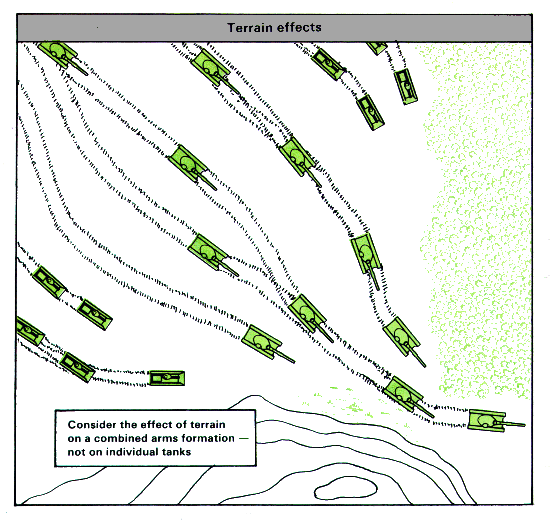
The previous section developed the concept of existing obstacles as a part of the terrain, and discussed their characteristics, identification, and analysis. This section considers the use and types of reinforcing obstacles that the commander can use to knit together, strengthen, and extend existing obstacles in support of his tactical plan. Reinforcing obstacles are those obstacles specifically constructed, emplaced, or detonated to extend or improve the effectivess of existing obstacles. They are placed for the purpose of anticipated military action or action already in progress.
|
ARE CREATED TO SERVE A PLANNED OR ON-GOING MILITARY ACTION. |
Many existing obstacles tend to be lengthy (rivers, canals) or broad in extent (forests, swamps). They can often more accurately be described as obstacle areas rather than a single obstacle. Existing obstacles are highly variable in effectiveness from place to place and have frequent gaps or openings between, and lanes (roads, bridges) through or over them.
|
TIE TOGETHER TO STRENGTHEN AND EXTEND EXISTING OBSTACLES. |
After thoroughly examining existing obstacles and obstacle areas, and then determining their relative stopping power, the commander has a much better feel for the use of reinforcing obstacles. Given the general tactical plan, time, logistic support, and manpower, the commander is able to add reinforcing obstacles to strengthen the terrain. Reinforcing obstacles normally are used to close gaps and block or close the lanes in the existing obstacle areas, or to enhance the obstacle value of the terrain. In some cases, they are used to extend natural obstacles or create obstacles or obstacle systems in open country.
The nature and extent of reinforcing obstacles is limited only by the imagination of the commanders or engineers who design them and the soldiers who emplace them. They are also limited by the logistic effort required. Reinforcing obstacles can range from massive systems such as the beach defenses constructed on the French coastline during World War II, or the extensive antitank obstacles in the 1973 Middle East War, to a road crater emplaced by an engineer squad. Reinforcing obstacles can vary greatly in type, method of emplacement, and logistic and manpower requirements. Reinforcing obstacles can be broadly categorized by the following types:
These categories are not mutually exclusive--some obstacles appear in more than one category and some (such as mines) are commonly used to strengthen others.
Demolition obstacles are created by the detonation of explosives, including nuclear explosives. Demolitions are commonly used to create reinforcing obstacles. There are two types of demolition obstacles, preliminary and reserved. Preliminary demolition obstacles are not absolutely critical to the tactical commander's plan, and do not require a formal written demolition order. They can be detonated as soon as they are prepared or as the tactical situation dictates. Reserved demolition obstacles are critical to the tactical commander's plan, and require a formal written demolition order. They are detonated according to the instructions in the order. Chapter 4 provides complete details on re served demolition obstacles. Some typical uses of demolition obstacles are:
Constructed obstacles are those reinforcing obstacles that are built by soldiers and machinery, generally without the use of explosives. Typical examples are:
Constructed obstacles generally require extensive amounts of one or all of the following:
Soldiers and construction equipment can be exposed to all types of enemy fire when emplacing constructed obstacles. Constructed obstacles should be emplaced prior to the start of the battle, or a terrain feature away from direct engagement areas, so that observed fire cannot disrupt the emplacement process.
Reinforcing obstacles other than minefield are primarily designed to enhance the fires and kill ratio of antitank weapons. Mines and minefield perform this function as well as killing or destroying enemy vehicles and personnel.
Mine warfare is undergoing a tremendous evolutionary process. Significant improvements have been made in mines and mine delivery systems. We have the capability to quickly emplace mines anywhere on the battlefield using various delivery systems. Mines have changed to the point where we now have to discuss them in two separate categories, conventional and scatterable mines. This categorization is required due to the different capabilities, employment techniques, and delivery means of each. Both categories of mines have a distinct place on the battlefield and complement each other.
Conventional mines are those mines not designed to self-destruct. Conventional mines are designed to be directly emplaced by hand or by mechanical mine planting equipment. They can be buried or surface-laid. Conventional mines can be emplaced in a classical pattern or without regard to pattern as the tactical situation dictates.
Scatterable mines are those mines which are designed to self-destruct after a set period of time. With the exception of the Wide Angle Side Penetrating Mining System (WASPMS) which is directly emplaced, scatterable mines are remotely delivered by ground systems, artillery, helicopters, and high-performance aircraft. The term "scatterable" refers to selfdestructing mines. It should not be used to describe conventional mines which have been laid without regard to pattern.
Scatterable mines have added a new dimension to mine warfare and the battlefield. The traditional concept of large linear minefield across contested areas between two forces is no longer viable, except possibly in desert warfare. Future battlefields will contain many smaller mined areas placed in response to enemy dispositions and movement. Scatterable mines will be employed against enemy units anywhere on the battlefield. Scatterable mines can be emplaced by a variety of delivery systems ranging from mechanical and explosive ground systems to artillery, helicopters, and high-performance aircraft. Scatterable mines significantly reduce manpower requirements associated with mine warfare. Scatterable mines are also smaller, lighter, and more lethal. They offer a reduction in logistical requirements due to reduced bulk and weight.
NOTE: The reader should beware of the terms "scatterable" and "Family of Scatterable Mines (FASCAM)" when referring to specific systems and their employment. Those generic terms are only applicable in the most general sense when discussing doctrine. Whenever possible, refer to the specific delivery system and the characteristics of that system, rather than the generic term.
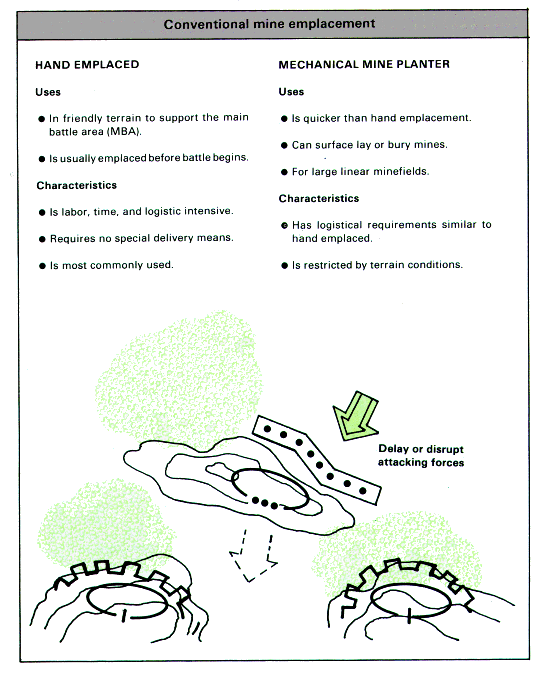
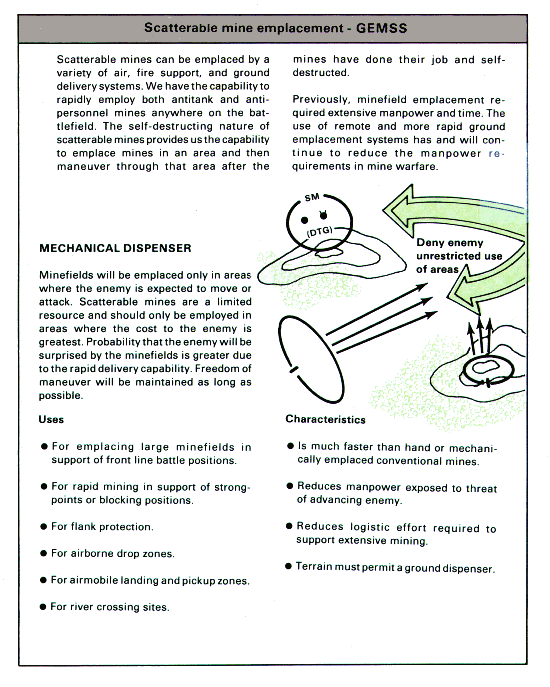
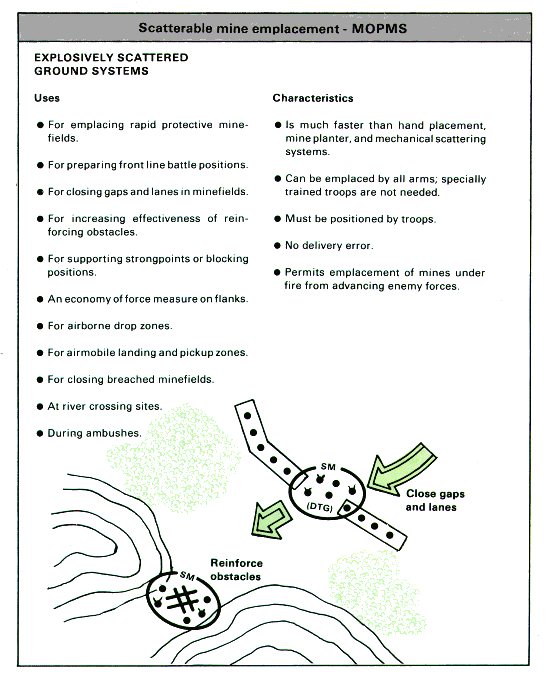
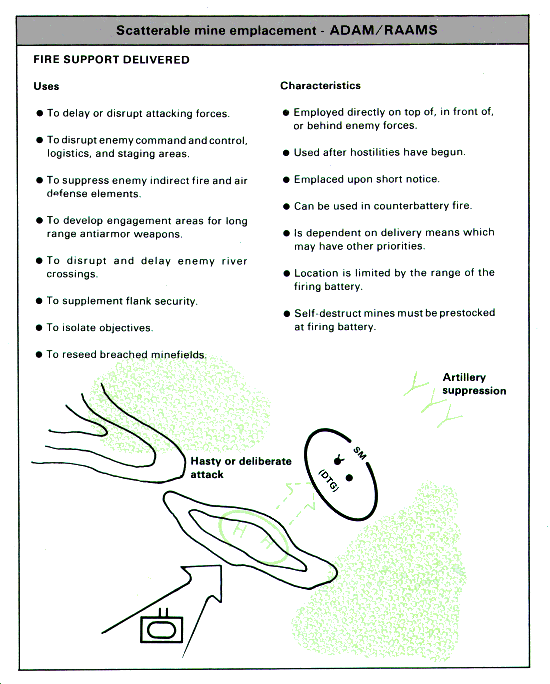
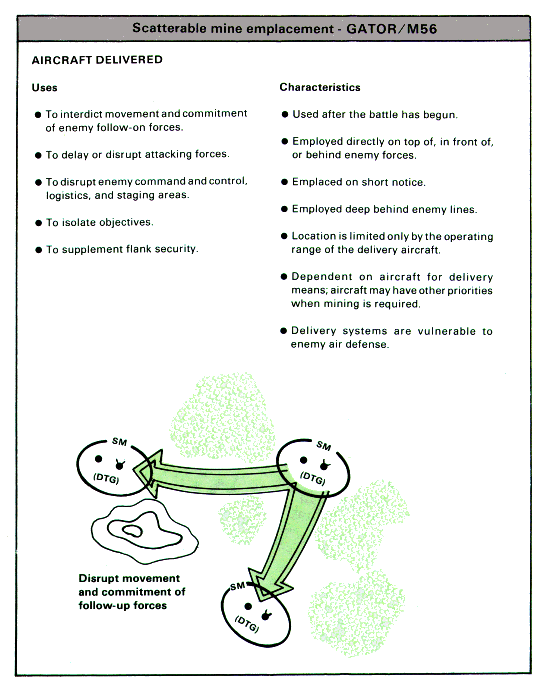
Mines are used extensively where the existing obstacle structure is weak or nonexistent. They should also be used with other reinforcing obstacles, such as tank ditches, to make breaching and clearing more costly and time-consuming to the enemy.
Since all scatterable minefield systems provide great flexibility to maneuver commanders, there will be extensive demands for them. Commanders and engineers should plan and carefully assign priorities. Available systems must be used for the most critical needs. Employment must be closely coordinated with obstacle plans, fires, and the scheme of maneuver. Coordination with fire support planners, aviation staff officers, and air liaison officers is essential to insure prior planning to execute minefield emplacement missions on short notice. Planning and employment of scatterable mines, as well as conventional mines, are discussed in depth in chapter 5.
Contamination can be either nuclear or chemical in nature. Both types are difficult to predict and control because they depend on winds for placement, and are subject to weather and other environmental factors. The United States has renounced the first use of chemical weapons. Further, the most predictable source of nuclear contamination, Atomic Demolition Munitions (ADM), is subject to the same restrictions as all nuclear weapons and may not be available for use when needed. If an ADM is used for cratering, there will be both close-in radiation and fallout, each effectively contaminating an area of reasonably predictable extent. Threat doctrine considers the use of both nuclear and chemical weapons, and threat forces train for operations in contaminated areas. The presence of contamination and its effects on the battlefield must be anticipated.
The potential of expedient obstacles is almost unlimited. They place a great premium on imagination and ingenuity in the use of available materials and other resources, thus avoiding the logistic burden associated with all other types of obstacles. All sorts of nonstandard log obstacles can be built. Their complexity depends upon the time and personnel available. Junked or destroyed cars and trucks or other debris can be spread to block an open area or, if the region is rocky, earthmoving equipment can be used to distribute boulders to block tanks. Selected trees can be pushed over to make an abatis or to strengthen a wooded area where tree spacing might otherwise allow armored vehicles to pass. Short ditches can be cut in lieu of craters. Material can be pushed up to form a road block. Equipment can steepen or deepen stream banks, gullies, or other breaks in the terrain to make expedient tank ditches. Trees can be cut or broken with a variety of vehicles or pieces of equipment. They can also be pushed or pulled down by winches to form expedient abatis or strengthen wooded areas. The M9 Armored Combat Earthmover (ACE), dozers, loaders, and many other pieces of equipment can also be used.
The wreckage of destroyed towns, cities, or industrial areas offers a source of materials to be used in making expedient obstacles. If permitted, limited controlled flooding can be used, not only to inundate areas, but also to create soft or slippery areas where soil conditions would make this possible. Timber bridges can be burned, and controlled fires can be used to create obstacles in other ways. For example, igniting the brush in a brush-filled ditch, at the proper time, can make an effective obstacle. If available, ice and snow can be exploited to create effective obstacles.
By their nature, expedient obstacles substitute locally available materials and soldier labor for a logistical requirement. All that is needed is the imagination to recognize the potential of available materials.
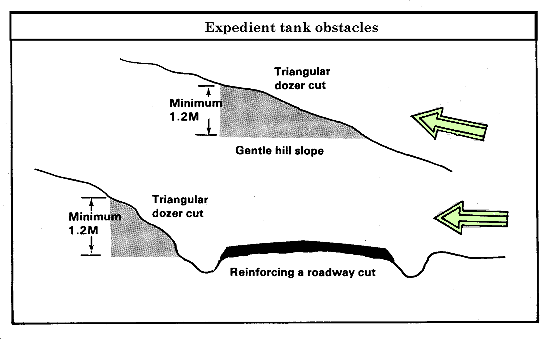
AirLand Battle doctrine gives the commander fighting the battle a complete range of defensive and offensive options. A static type defense can be used to focus upon terrain retention using firepower from fixed positions to deny terrain. The commander can also defend using a dynamic defense that focuses upon maneuver to destroy enemy forces rather than retain specific terrain.
The static and dynamic defensive frameworks are the extremes of the spectrum. Typically, the commander may choose to combine both the static and dynamic forms in organizing the defense based upon the factors of mission, enemy, terrain and weather, time, and troops (METT-T).
Whatever the concept, organizing the defense must be carefully matched to the terrain. The engineer is the principal element in reinforcing the terrain to best complement the maneuver commander's plan. The engineer and the maneuver commander must coordinate throughout the planning and battlefield preparation sequence to insure unity of effort and maximum effectiveness of obstacle employment.
Terrain reinforcement techniques must be employed along the depth of the enemy's formation and avenues of approach where existing terrain places him at the greatest disadvantage. Use of reinforcing obstacles is the principal method of terrain reinforcement. Reinforcing obstacles must be used in conjunction with the existing obstacles and the commander's plan. Reinforcing obstacles have three primary purposes:
1 Enhance the effectiveness of friendly antitank fires.
2 Delay the enemy's advance, upset his timing, disrupt and channelize his formations, and delay or destroy follow-on echelons.
3 Enhance friendly economy of force measures.
Obstacles must be covered by fire if at all possible. They should be located within the effective range of friendly direct fire antitank weapons. Their locations must be carefully coordinated with the location of battle positions and direct and indirect weapons. We want to engage the enemy at the maximum effective range of our antitank weapons, and force him to breach and fight his way through a series of obstacles while under intense fire. Each obstacle delays some part of the enemy's leading elements.
|
SIGNIFICANTLY ENHANCE ANTITANK FIRES. |
The coordinated use of obstacles can delay and disrupt enemy formations, and also force them into the primary fields of fire of our tanks and other antitank weapon systems, or prevent escape from such an engagement area. The enemy is forced to move on the battlefield in conformance with the friendly commander's plan.
|
DELAY, DIVERT, CANALIZE, AND DESTROY THE ENGAGED ENEMY AND FOLLOW-ON ECHELONS. |
The skillful use of obstacles to channelize the enemy is a vital factor. Once the enemy force maneuvers into the engagement area, it is held there by other groups of obstacles, and still others may be used to close the trap behind it. (Scatterable mines are ideal for the latter purpose.) Other obstacles are used to separate the enemy's leading elements from reserves or following echelons, thus precluding reinforcement.
Mutually supporting obstacles serve other important purposes. They can be used in the economy of force role to strengthen a naturally strong existing obstacle area so that it need only be lightly defended, thus freeing forces to be concentrated elsewhere. Similarity, obstacles can be used in conjunction with mobile forces to protect flanks and other lightly defended areas. This is a particularly important role in view of the threat doctrine of penetration and envelopment, and the overall dispersion of forces on the battlefield.
Regardless of the type defense employed by the tactical commander, there are five basic employment principles for reinforcing obstacles:
1 Reinforcing obstacles support the maneuver commander's plan.
2 Reinforcing obstacles are integrated with observed fires.
3 Reinforcing obstacles are integrated with existing obstacles and with other reinforcing obstacles.
4 Reinforcing obstacles are employed in depth.
5 Reinforcing obstacles are employed for surprise.
1 Reinforcing obstacles support the maneuver commander's plan. Reinforcing obstacles must be planned and emplaced to support the tactical plan. Obstacles other than mines emplaced outside the range of friendly weapons are of little use. Reinforcing obstacles that do not accomplish one or more of the basic purposes of reinforcing obstacles are also of little value. Engineers must be completely familiar with the tactical plan, the existing terrain, and the maneuver commander's intentions. Only then can full advantage of the multiplier value of integrating obstacles and fires be realized.
2 Reinforcing obstacles are integrated with observed fires. Obstacles are used to develop engagement areas in which enemy maneuver is restricted and slowed, thereby increasing the hit probability of friendly direct and indirect fires. The tactical commander and the engineer site the weapons and obstacles which offer the best relative advantage, and consider terrain configuration and the effective weapons range. Special attention must be given to locating obstacles to complement the fires of Dragon, tanks, and tube-launched, optically tracked, wire-guided missiles (TOWs). Since TOWs have a greater maximum effective range than Threat tanks, it is to our distinct advantage to site part of the tactical obstacle system to capitalize on that difference. Generally, the greatest relative advantage accrues when the obstacle is at the maximum range possible and consistent with visibility conditions and the tactical plan. Observed indirect fires are also used in conjunction with obstacles against enemy vehicles and infantry out in the open. Observation and adjustment of fires are essential if the full advantage is to be developed. At the same time, fires serve to protect the obstacle by making it costly to breach or bypass. With rare exceptions, obstacles that are not covered by fire are little more than a nuisance to the enemy's leading elements.
Keep in mind, however, that the principal purpose of integrating obstacle locations with fire is to enhance the effectiveness of those fires--a significant combat multiplier effect of obstacle use.
3 Reinforcing obstacles are integrated with existing obstacles and with other reinforcing obstacles. Reinforcing obstacles are sited to take the maximum advantage of existing obstacles. They are placed where they can close the gaps or openings between existing obstacles and/or close any passages through them. The road network must be destroyed and the inherent natural pattern of cross-country movement should be disrupted. The first obstacles planned are bridge demolitions, road craters, abatis, and point or small minefield that tie together the existing obstacle areas and close the passages through them. Other reinforcing obstacles are then located to strengthen and extend the existing obstacle areas and block major corridors. Taking advantage of the existing obstacles reduces the resources required to quickly obtain an effective obstacle system. Effective reinforcement of existing obstacles also enhances economy of force operations by permitting friendly forces to concentrate on more trafficable terrain approaches.
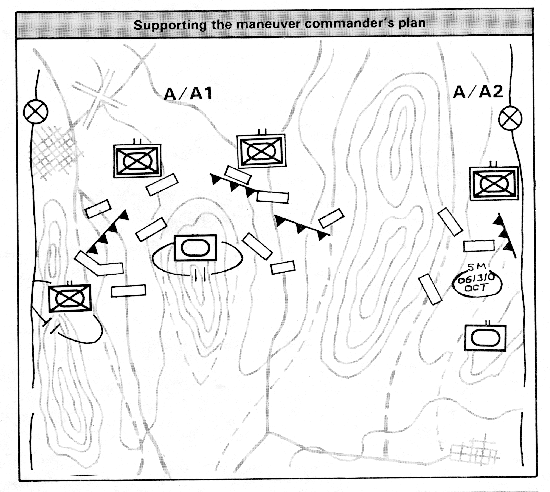
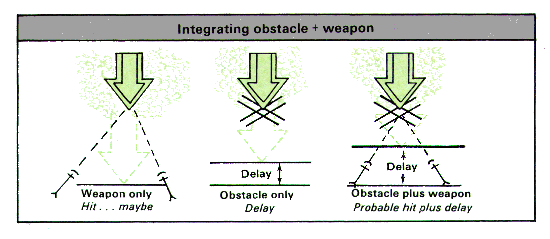
Individual obstacles must be sited and designed to tie in with existing obstacles or with each other. An obstacle that can be bypassed immediately is worthless. Each individual obstacle must be carefully designed for the exact location it will occupy, and must overlap on each side with the existing obstacle it will complete. The critical design width of an obstacle is the distance from an existing obstacle to another existing obstacle (or to another reinforcing obstacle), and not the width of a road or highway through the existing obstacle.
Another major design consideration is that the reinforcing obstacle does not need to be stronger than the integrated existing obstacle. The obstacle should be no more difficult to breach than it is to get around. If the enemy could force his way through the existing obstacle in the immediate vicinity in 10 minutes, it would be wasteful to construct a reinforcing obstacle requiring 40 minutes to breach. The effort and resources used to obtain the last 30 minutes of breaching time are desperately needed elsewhere. Although the delay or breaching time associated with a particular obstacle may be difficult to determine, this principle must nevertheless be kept in mind to obtain the most use of available resources.
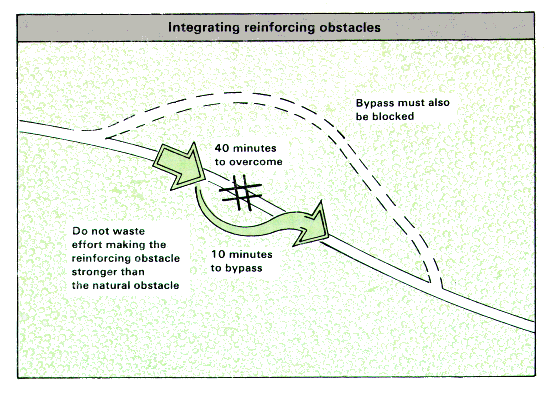
Reinforcing obstacles are integrated with each other to assure that probable bypass routes are closed. For example, destruction of a major highway through a wooded area is largely ineffective if any nearby road or opening that offers a ready bypass route is left open. (Such destruction could be highly effective, however, if friendly forces were seeking to divert the enemy along that bypass route.) Reinforcing obstacles can also be used to close gaps and lanes in other reinforcing obstacles. For example, a crater can be used to close a road left open through a minefield when all friendly troops have cleared.
4 Reinforcing obstacles are employed in depth. A series of simple obstacles arranged one behind the other along a probable axis of enemy advance is far more effective than one large, elaborate obstacle. Restricting the design of obstacles to correspond with the strength of the existing obstacle (as previously discussed) helps to conserve effort and direct it toward executing obstacles in depth. Obstacles must not be located too close together so only a single enemy response is required. They must be far enough apart that each will require a new deployment of the enemy's counterobstacle forces and/or equipment. The distance between obstacles will depend on the terrain and the obstacle effort available. Proper use of obstacles in depth wears the enemy down and significantly increases the overall delay. At each new obstacle, he incurs losses and is forced to stop and react. This wearing down effect is psychologically significant. The desired effect is to degrade the enemy soldier's will and induce a feeling of hopelessness. This can be done by convincing him that, beyond each new obstacle (with its attendant loss of personnel and equipment), there awaits another obstacle with a similar cost; and, beyond that one, yet another, and so on. Another reason for using a greater number of less elaborate obstacles is that each one forces the enemy to expose his limited counterobstacle equipment and troops to loss. When the counterobstacle resources initially allotted to the leading elements have been destroyed, the enemy's movement will be severely slowed until new counterobstacle units can be brought forward.
5 Reinforcing obstacles are employed for surprise. Using obstacles so as to obtain surprise is one means available to the commander to retain a degree of initiative even when defending. Scatterable mines permit rapid mining anywhere in the battle area, confronting the attacker with a completely new situation almost instantly. The self-destruct feature of the scatterable mine also provides surprise--a friendly counterattack may be launched through an area that was mined prior to the attack but where the mines have just self-destructed.
More conventional ways to obtain surprise are also available and should be used. They include the sudden detonation of concealed obstacles in front of the attacking enemy or within his formations. Conventional ways also include the use of phony obstacles to mislead the enemy as to the pattern and extent of the friendly obstacle system. An obvious pattern of obstacles would divulge locations of units and weapons. Friendly forces must avoid readily discernible, repetitive patterns. By varying the type, design, and location, the enemy's understanding and breaching of our obstacle system is made more difficult. Extensive use of obstacles can make a major contribution to this effort.
Reinforcing obstacles which complement the existing obstacle value of the terrain, and are designed and emplaced to support the maneuver plan, are an effective "combat multiplier." Tactical commanders and engineers must exploit the full value of obstacles.
Obstacles are classified as either existing or reinforcing. Existing obstacles are those natural and cultural restrictions to movement that are a part of the terrain when battle planning begins. The ability to recognize and evaluate the obstacle potential of the terrain is critical to planning the battle. Reinforcing obstacles are constructed, emplaced, or detonated to knit together, strengthen, and extend exisiting obstacles.
Reinforcing obstacles must be integrated with friendly observed fires, the friendly commander's maneuver plan for both the enemy and friendly forces, and existing and reinforcing obstacles. Reinforcing obstacles must also be arrayed in depth and employed for surprise.
Mines are generally the most effective type of obstacle because they also inflict losses on the enemy, and their use is highly flexible. The Family of Scatterable Mines (FASCAM) vastly increases this flexibility, making the creation of rapid minefield possible.
Obstacles are also used to delay and disrupt an attacking force, upset the enemy's timing and plans, and divert him into engagement areas and be destroyed. Obstacles can delay or destroy follow-on echelons.
Obstacles can significantly enhance the effectiveness of our fires and thus our ability to win the battle.